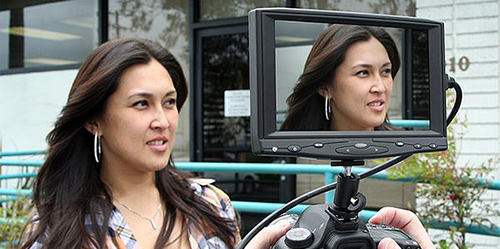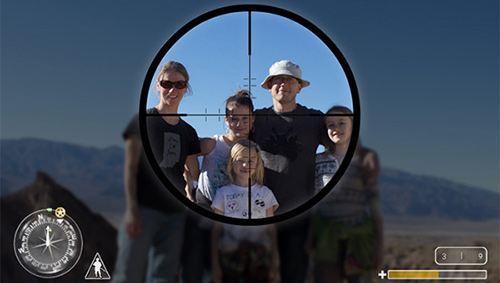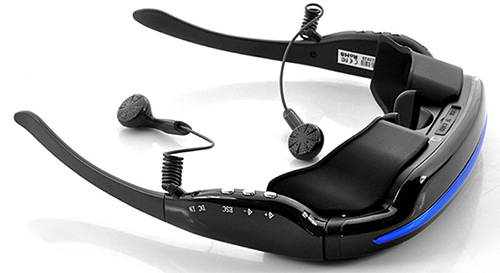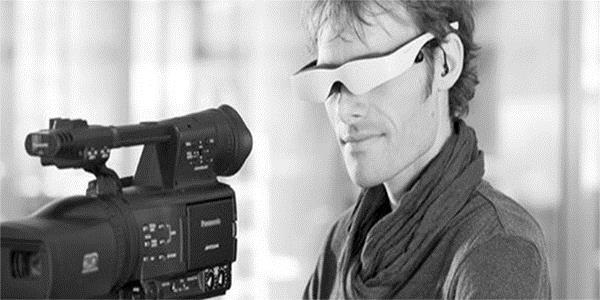Despite the fact external monitors have dropped in price considerably over the years, they still cause many difficulties for filmmakers and photographers that have small production crews. Even the most accessible external monitors can be fiddly and difficult to see properly in bright locations, often making their unique selling points not worth the hassle.
Video Glasses can be connected to a DSLR camera via HDMI or analog video interface to convert it into an exterior viewfinder. It almost seems like a director or photographer’s dream come true, especially ones that are conscious of idiosyncratic visual styles.
Now the technology within the video glasses field is quickly developing, it seems all of the hindrances that accompany external monitors have been revised with these not so new gadgets.
1. Hands free/Practical

Unlike even the smallest external monitor you do not need to hold it, put it on a stand or even attach it to the camera. You simply leave it on your head and when you need to look around you just lift them up as you would with a normal pair of sun glasses.
Interesting images from new perspectives are possible without forcing the filmmaker into uncomfortable positions. For example, a camera can be mounted to a telescope arm to capture professional and well composed images from a bird’s eye view.
Also the video glasses could make steady cam usage a much smoother process by allowing you to move your head with the camera. Anyone that has used a steady cam will tell you that attempting to lock your head towards the monitor and create smooth movements can be a multitasking headache.
2. Light Blocking

Like any pair of Ray-Bans (aesthetics and brand aside) blocking out ambient light is their primary function and a function they do very well. As a result of this filmmakers and photographers are enabled to view an image in the mobile glasses without being visionless by sunlight. Often photographers and D.Ps use an LCD sun hood that extends over the monitor to shade it from the lights raise. However, not only does this add to the bulk of the camera, but even the best quality sun hoods do not block the light completely. It has been known that some people even use the classic technique of covering their heads and monitors with a fabric sheet.
This is an issue composition obsessed cinematographers have had for quite some time now and often prevents them making the most of potential framing opportunities. The video glasses takes all of the benefits from external monitors and closed viewfinders and disposes of their disadvantages. They close off light similar to a classical viewfinder, but have the practical accessibility that we once associated with external monitors.
3. Bigger Picture

Video glasses also allow you to measure the quality of an image at pretty much any time or any place, so making changes to the camera’s settings can be done accessibly without making any “easily overlooked” mistakes. This applies mainly to smaller things in the shot that you would usually have to zoom in to inspect. For example – if a person is blinking or there is something in the background of the shot that affects the overall image quality, things like this would be far easier to spot with the visual span the video glasses gives you.
This is especially relevant with manual focusing, the video glasses gives you access to such close up details it makes even the shallowest depth-of field shots much easier to focus. One of the most common complications that come with using good 50mm or 30mm lenses is achieving that sharp focus with such sensitive focal perimeters. The shallower the depth-of-field the more accurate your focus needs to be, having a detailed view of your image can be a make or break in this situation.
4. 3D playback

Pretty much all video glasses on the market are 3D ready and even within the indie filmmaking world 3D is more popular than ever. In 2012 the Korean film “The Fish” was the first 3D film to be premiered at the Rotterdam International Film Festival. So even regarding the longevity of filmmaking it seems video glasses are corresponding well with major trends.
Watching 3D playback on the glasses is much more time friendly and practically economic than using monitors, especially for low budget and indie productions. The video glasses could allow you to speed up the production time when shooting on digital 3D and although it won’t guarantee better quality, it makes what is usually a very awkward and time consuming process far more digestible.
Matthew Carter researches for Birmingham (UK) based gadget and Technology Company Hitari trade. He is also part of the West Midlands based film collective Black Country Cinema.






